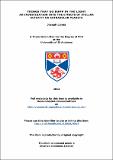Files in this item
Things that go bump in the light : an investigation into the effects of stellar activity on extrasolar planets
Item metadata
| dc.contributor.advisor | Jardine, Moira | |
| dc.contributor.author | Llama, Joseph | |
| dc.coverage.spatial | 163 | en_US |
| dc.date.accessioned | 2014-06-24T10:07:12Z | |
| dc.date.available | 2014-06-24T10:07:12Z | |
| dc.date.issued | 2014-11-30 | |
| dc.identifier | uk.bl.ethos.605818 | |
| dc.identifier.uri | https://hdl.handle.net/10023/4907 | |
| dc.description.abstract | The search for planets orbiting stars other than the Sun has led to the discovery of over one thousand new worlds. The majority of these planets have been very large, Jupiter sized planets located very close to their host star. Transit surveys such as Kepler and SuperWASP monitor thousands of stars looking for periodic dips in light caused by a planet passing between our view point on Earth and their host star, blocking a fraction of the emitted star light. One of the primary limitations in detecting a small, Earth sized planet comes from stellar activity induced signals within the data collected by exoplanet missions. These signals can, however, be used to our advantage. In this thesis, asymmetries in transit light curves are exploited to reveal properties of both the planet and the host stars themselves. An asymmetry in the near-ultraviolet transit light curve of WASP-12b, one of the largest and hottest planets found to date is thought to be caused by the stellar wind interacting with the magnetic field surrounding the planet. In this thesis, a model for such an interaction is developed and is shown to be consistent with the observations, providing the first potential evidence for the presence of a magnetic field around an exoplanet. The model is then extended to predict the shape of near-ultraviolet light curves around HD 189733b, another hot Jupiter that orbits a very bright star. By looking at the variability in these transit light curves over time, the evolution and structure of the stellar wind is investigated. By tracking the position of bumps in the transit light curve, it is shown here that the data collected by missions such as Kepler has the potential to reveal stellar butterfly patterns. Such patterns are intrinsically linked with the stellar dynamo which governs the properties of the stellar magnetic field. Finally, the support of large-scale magnetic loops on young stars is investigated. These loops trap large amounts of hot, dense material and so a rapid destabilisation could lead to a flaring event, which could have devastating consequences for a nearby exoplanet. | en_US |
| dc.language.iso | en | en_US |
| dc.publisher | University of St Andrews | |
| dc.rights | Creative Commons Attribution-NonCommercial-NoDerivatives 4.0 International | |
| dc.rights.uri | http://creativecommons.org/licenses/by-nc-nd/4.0/ | |
| dc.subject | Astronomy | en_US |
| dc.subject | Astrophysics | en_US |
| dc.subject | Exoplanets | en_US |
| dc.subject | Stars | en_US |
| dc.subject | Magnetic fields | en_US |
| dc.subject.lcc | QB820.L6 | |
| dc.subject.lcsh | Extrasolar planets | en_US |
| dc.subject.lcsh | Stars--Magnetic fields | en_US |
| dc.title | Things that go bump in the light : an investigation into the effects of stellar activity on extrasolar planets | en_US |
| dc.type | Thesis | en_US |
| dc.type.qualificationlevel | Doctoral | en_US |
| dc.type.qualificationname | PhD Doctor of Philosophy | en_US |
| dc.publisher.institution | The University of St Andrews | en_US |
This item appears in the following Collection(s)
Except where otherwise noted within the work, this item's licence for re-use is described as Creative Commons Attribution-NonCommercial-NoDerivatives 4.0 International
Items in the St Andrews Research Repository are protected by copyright, with all rights reserved, unless otherwise indicated.


